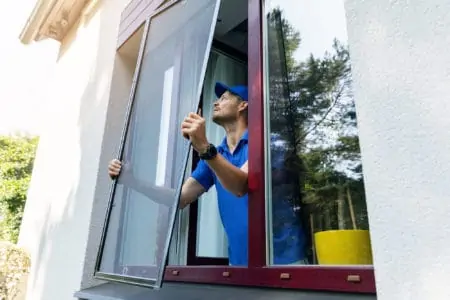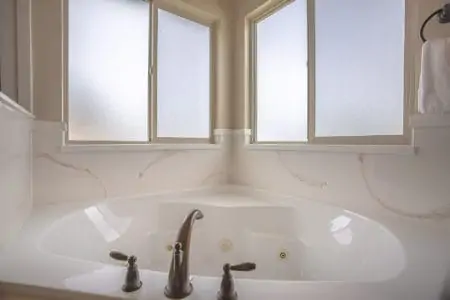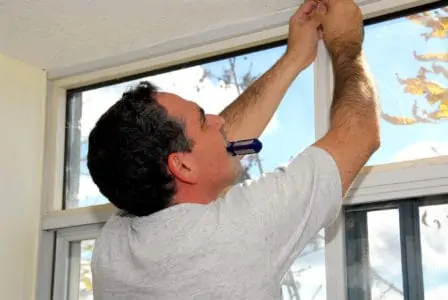Window screens get dirty and damaged, especially when fixed in place all year round. Knowing how to remove window screens helps you maintain them and ensures that they don’t get damaged during removal.
We show you how to remove a screen from a window in easy steps and offer advice on removing screens from different window types.
Key Takeaways
- Remove window screens to clean, repair, or replace them.
- Most modern screens can be removed from inside the property.
- Different window types have specific methods for screen removal.
- Ensure safety when using a ladder and tools for screen removal.
When Should Window Screen Be Removed?
Window screens suffer damage just like any other external part of your house. The wind, rain, and frost all take their toll. Accidental damage is another common reason to remove your window screen for repair.
Aside from kids playing ball in the yard, here are some other common reasons to remove a window screen:
- To clean the window from the outside.
- To swap a torn screen for a new one.
- To clean the screen.
- Heavy snowfall is forecast.
- A hurricane is coming.
- To winterize the exterior of your home.
When you remove the screen, you want to do it safely, without breaking it. You also want to minimize damage to the exterior of your house, like sidings and shingles.
How to Remove a Window Screen from the Inside
Most modern screens are designed to be removed from inside the property. This is especially useful for bedroom windows you can’t (or don’t want to) reach with a ladder.
Before you begin, check whether your screens come with tabs, latches, or pins.
- Fully open the window.
- Grab the tabs on the top of the screen and pull them downward. This forces gentle pressure on the springs at the base of the screen. Some screens come with pins or latches, which you need to disengage before removing them.
- Pivot the screen to make it easier to get it out of the frame.
- Once free, place the screen to one side for cleaning or replacement.
How to Remove a Window Screen from the Outside
Removing ground floor screens from outside is easier because they are accessible, but upper floors will need a ladder. You will also need a couple of tools like a putty knife and a flat-head screwdriver.
Think Safety
Always ensure that the ladder’s feet are on stable, flat ground and that you don’t over-extend your reach. If you lose balance, you risk serious injury if the ladder slips.
- Start in the lower left-hand corner.
- Push gently on the screen as it comes away from the corner. If the screen only partially comes away, it should expose enough of the frame to use your tools for leverage.
- Slide the putty knife under the frame in the bottom left-hand corner.
- Now insert the flat-head screwdriver under the frame on the lower left-hand vertical corner. Gently ease it towards you.
- Grab the exposed corner and gently move it upward while pulling the screen towards you.
- Once the frame is almost out, use the screwdriver to ease the right-hand corner from the pocket.
- Once the base of the frame is free of the housing, pull down, and the screen should release.
Always keep your working area clear of trip hazards and adopt the correct stance when lifting the screen. Plant both feet shoulder length apart, with one foot slightly in front of the other.
How to Take a Screen Out of Different Windows
Some window frames have spring clips as part of the window frame track. Others come without springs but simply clip onto the frame for stability.
Knowing how to remove screens from different window styles will help protect your screen against damage.
Removing a Screen from a Hung Window
Screens for hung windows either have a spring-loaded clip as part of the screen or as part of the window frame. To remove the screen, you will need to disengage the spring.
Push up the top part of the screen with one hand on the spring. Now release the tabs at the base and push the screen outward. The screen should unclip from the frame, enabling you to twist if free.
Without tabs or pins at the base of the screen, you will need to use the putty knife to pry the bottom free. Be careful not to bend the frame.
The procedure for removing a screen from a sliding window is almost identical to the way you replace a screen from a hung window.
- Fully open the window.
- Locate the tabs or pins and push them towards the center of the screen. At the same time, pull the tabs towards you.
- Remove the screen by tilting it out.
How to Remove a Screen from a Vinyl Window
Some screens have tabs on the top and springs on the base. The procedure is slightly different when removing these screens.
- Pull down the tabs on the top of the screen, which applies gentle pressure on the springs at the base of the screen.
- As the springs release, the top of the screen coomes free of the frame.
- Tilt the top of the screen inwards and lift to remove the base.
How to Remove a Screen from a Casement Window
When the casement window opens from the right, the screen tabs are typically located on the same side. The reverse is common for windows opening on the left.
- Locate the tabs based on the way the window opens.
- Pull the tabs inward towards the center of the screen.
- Remove the right side of the screen by tilting it towards you.
- Now remove the left side of the screen and place it somewhere safe.
Why Won’t My Window Screen Come Out?
There are several reasons why your window screen could be stuck. The important thing is to use just enough force to remove them without causing damage. You should only try this on vinyl screens because they are pliable, so they can take a bit of flexing.
Frozen Screen
One common complaint with stuck screens is the tabs or pins are frozen solid. As the temperature plummets, the moisture on the screen freezes.
One of the best solutions is to use antifreeze on the clips to melt the ice. If you don’t have antifreeze, you could always insert a putty knife into the frame where the tabs meet the wall. With the blade in place, wiggle it gently to remove the ice and free the tab.
With your free hand, pull the tab towards the center of the screen to try and dislodge any blockage. Another tip is to use hot water to melt the ice.
Take Note
Don’t use boiling water because the extreme temperature change could cause the screen to crack.
Rusted Pins
Sometimes the pins that hold the screen in place get rusted. If this happens, you will need to get the pin out without causing damage. One useful product to keep in your tool kit is WD:40. Spray it liberally on the stuck pin and wiggle the pin back and forth.
Eventually, it should work free.
If you haven’t got WD:40, spray furniture polish will lubricate the pin.
Swelling
Heat and cold cause your window screens to expand and retract. The easiest way to get a swollen screen out is to use the wiggle and jiggle method.
Remove all window coverings and mounting brackets to give you more space with fewer restrictions.
Disengage the pin from the bottom corner of the screen and slide the putty knife into the gap between the screen and the frame.
Twist the knife and gently force the screen towards you so that the corner protrudes from the frame. Grab the corner and keep pulling inwards while applying pressure to the opposite top corner.
Now it’s time to wiggle and jiggle the screen, working it until one side slides free and you can pull the screen out.
How to Put a Screen Back In a Window
Pop the top part of the screen onto its track while holding the base at a slight angle. Now line the bottom of the screen with the track and push it in place, pulling the two side tabs inwards to retract the clips.
Once the screen is flush with the track, release the tabs to engage the clips. Give the screen a gentle tug to see if it is secure.
FAQs
Love Your Screens
Screens provide a valuable service. They stop insects from invading our homes, enabling the windows to be kept open in the summertime. However, typically made from vinyl frames and mesh, window screens are fragile.
Showing your window screens some love by cleaning and maintaining them could give you years of useful life.









